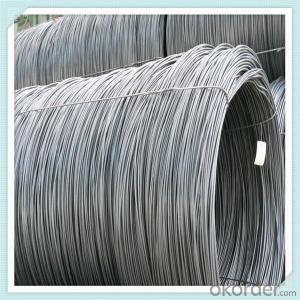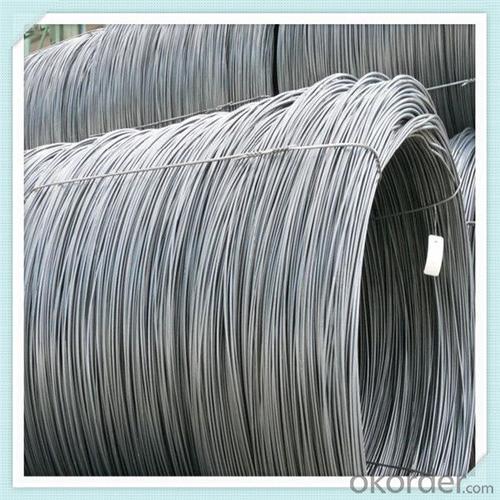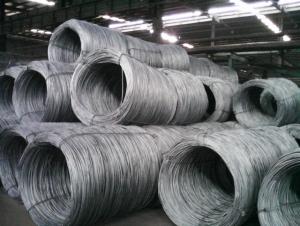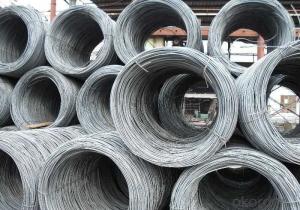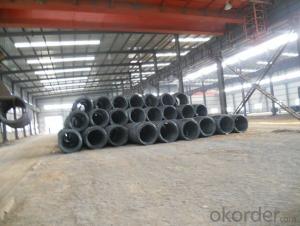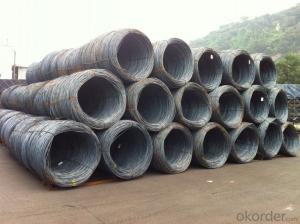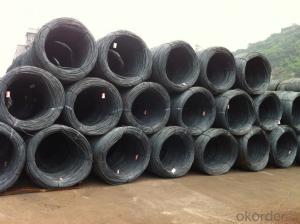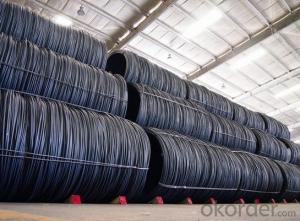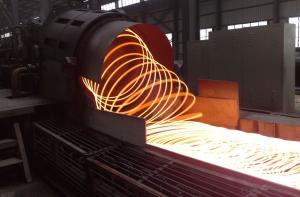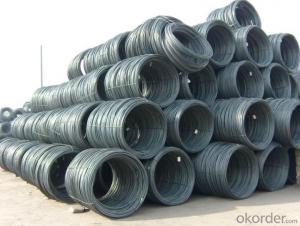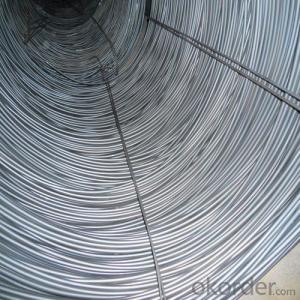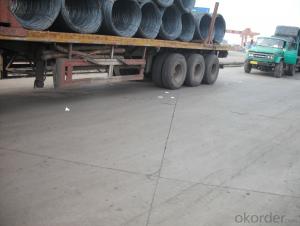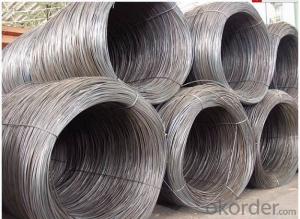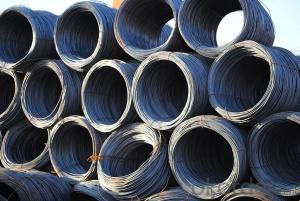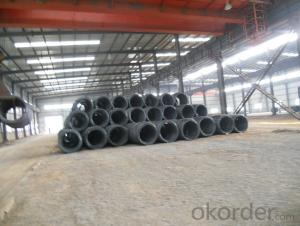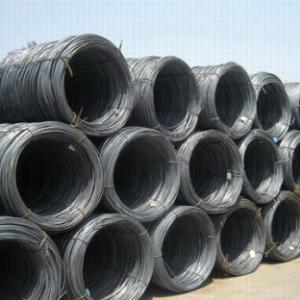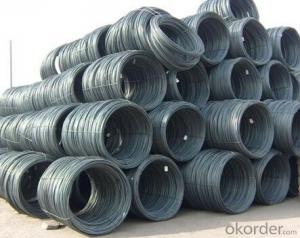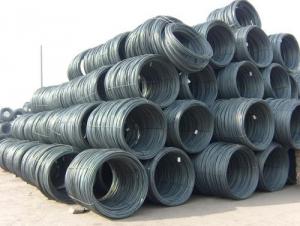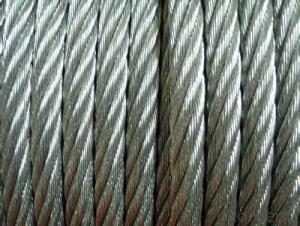SAE1008 Steel wire rod low carbon in good quality
- Loading Port:
- China main port
- Payment Terms:
- TT OR LC
- Min Order Qty:
- 100 m.t.
- Supply Capability:
- 18400 m.t./month
OKorder Service Pledge
OKorder Financial Service
You Might Also Like
Specification
Features
1、Pure steel quality, stable chemical contents, small tolerance.
2、Constant Quality, good drawing performance.
3、High dimension accuracy degree, accuracy degree of Level C up to 80%, smooth surface, less scale,
easy to be pickled.
4、Automatic bundling with 4 lines by Machine in tidy and good looks
5、Big high quality percentage, small coil percentage, and heavy coil weight for Hard Coil.
6、High sorbitizing percentage.
Steel wire is mainly used for prestressed and posttensioning technology in various shapes of prestressed
concrete structures,and widely used for civil engineering construction, such as large scale railroad, highway
bridges, building trusses, overhead crane beams, industrial and prefabricated concrete floor, wall board,
tubular piles, PC water pipes, TV towers and nuclear power station, ETC. Active strandards:GB/T5223,
ASTMA421, BS5896, JISG3536, ISO6934, EN10138 or other special required standards.
Product Description :
Standard | AISI, ASTM, BS, DIN, GB, JIS |
Material/steel grade | Q195-Q235,SAE1006B,SAE1006CR, SAE1008B, SAE1008CR, SAE1010B, SAE1018B, or according to customers requirements |
Wire Gauge | 5.5-12mm |
Coil weight | 1.8-2.1mts |
MOQ | 25MT |
Delivery Time | 15-30 days after receipt of L/C or deposit by T/T |
Packing | In coil and load in container, if large quantity, by bulk vessel; Can be packed as customers' special requirements |
Payment terms | 1).100% irrevocable L/C at sight. 2).30% T/T prepaid and the balance against the copy of B/L. 3).30% T/T prepaid and the balance against L/C |
Application | widely used in machinery parts, manufacturing industry, electronics industry, metal tools and others |
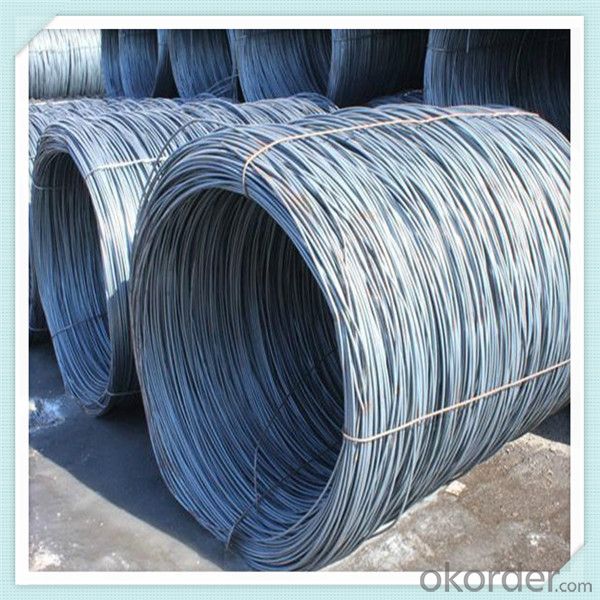
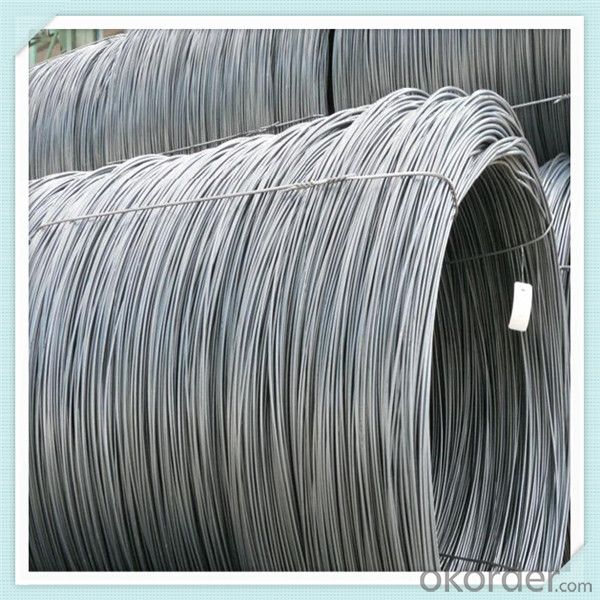
Application :
It generally used in braiding the hose for bathing product and machinery. With it
good flexibility, resistant to high temperature and resistant to corrosion, it
used widely in many industries.
Packing :
Hot-rolled wire rod is held in a unit with at least four steel straps in the
transverse direction and transported and stored without further packaging.
Before
the steel strapping is applied, the wire rod must be sufficiently compressed.
The strapping is fixed in the transverse direction with a single circumferential
strap so that the strapping does not slip and cause the coil to come apart.
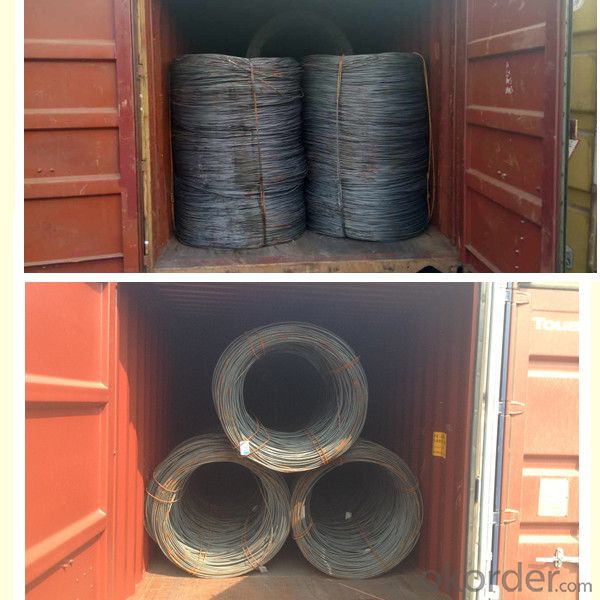
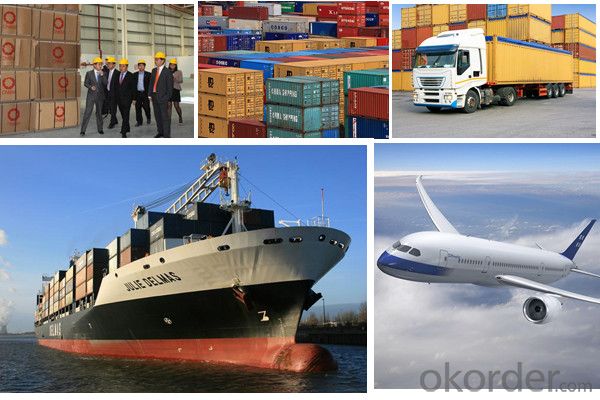
Our service:
(1) We cooperate with famous factories with advanced equipment and well trained workers.
(2) We can provide factory price with trading company service.
(3) We continuously work on the improvement of our processes, guaranteeing
consistently high standards of quality to keep none compensation.
(4) We guarantee 24 hours response and 48 hours solution providing service.
(5) We accept small order quantity before formal cooperation.
(6) We deliver the agreed quality at the agreed time, reacting to changes in
customer wishes in a flexible way.
(7) Due to our volume and selling power, we have excellent freight rates with
shipping lines.
(8) We strive to always be fair and honest in our dealings with customers.
(9) We strive to work together with customers to achieve much more than we can
achieve alone.
(10) Through our passion and commitment we aim to be a market leader in all our
key markets. To maintain our position as market leader we must continue to add
value in all that we do.
FAQ:
1.Q: What's your MOQ(minimum order quantity)?
A: One full container, mixed acceptable .
2. Q: What's your packing methods?
A: Packed in bundle or bulk ..
3. Q: How can I buy CNBM products in my country?
A:Please send us an inquiry or email ,we will reply to you if there is distributor in your country
4. Q: Can we visit your factory?
A: Warmly welcome. Once we have your schedule, we will arrange the
professional sales team to follow up your case.
5. Q: How long does it take to get the product if i place an order?
A:With the process of your requirements,we will pack and deliver in 3
-7 days. If it is by sea shipment,it will take 15-45 days depending on different locations
- Q: What are the different testing standards for steel wire rod?
- To guarantee the quality and performance of steel wire rod, various testing standards are employed. These standards encompass different aspects of the wire rod, such as its chemical composition, mechanical properties, surface condition, and dimensional tolerances. Among the most prevalent testing standards for steel wire rod is the ASTM A510/A510M standard. This standard outlines the prerequisites for carbon steel wire rods and incorporates tests like chemical analysis, tensile strength, elongation, and reduction of area. It also includes guidelines for the wire rod's surface quality and dimensional tolerances. Another widely utilized testing standard for steel wire rod is the ISO 16120-1 standard. This standard specifies the general requirements for steel wire rod and includes tests such as chemical analysis, tensile testing, and surface inspection. Additionally, it provides guidelines for the dimensional tolerances and packaging of the wire rod. Furthermore, specific testing standards exist for steel wire rod used in particular industries or applications. For instance, the ASTM A961/A961M standard outlines the requirements for low-alloy steel wire rods used in prestressed concrete and includes tests such as tensile strength, yield strength, and elongation. Similarly, the ISO 6935-2 standard specifies the requirements for steel wire rod utilized in the production of wire for general purposes and includes tests such as tensile strength, elongation, and torsion. In conclusion, the diverse testing standards for steel wire rod guarantee that the product meets the necessary specifications and can perform reliably in its intended applications. These standards instill confidence in manufacturers, suppliers, and customers regarding the quality of the steel wire rod and ensure its suitability for use across various industries and applications.
- Q: How is steel wire rod used in the manufacturing of wire for electrical transformers?
- Steel wire rod is used in the manufacturing of wire for electrical transformers by being drawn and annealed to achieve the desired diameter and mechanical properties. This wire is then further processed and coated with insulation material, such as enamel, to enhance electrical conductivity and prevent short-circuits. The resulting wire is coiled and used as the primary or secondary winding in transformers, playing a crucial role in transmitting and transforming electrical energy efficiently.
- Q: How is steel wire rod used in the manufacturing of wire for construction reinforcement grids?
- Steel wire rod is a primary raw material used in the manufacturing of wire for construction reinforcement grids. It serves as the starting point for the wire production process. The steel wire rod is first drawn through a series of dies to reduce its diameter and increase its length, resulting in a smoother and more uniform wire. This wire is then further processed and formed into the desired shape and size to create the wire mesh used in construction reinforcement grids. By providing the necessary strength and durability, the steel wire rod ensures the wire mesh can effectively reinforce concrete structures, enhancing their structural integrity and longevity.
- Q: What are the common applications of high-strength steel wire rod?
- High-strength steel wire rods have a wide range of applications across various industries due to their exceptional strength and durability. Some of the common applications of high-strength steel wire rods include: 1. Automotive industry: High-strength steel wire rods are extensively used in the automotive industry for manufacturing various components such as springs, suspension systems, seat frames, and reinforcement bars. The high tensile strength of these wire rods ensures enhanced safety and stability in vehicles. 2. Construction industry: Steel wire rods find extensive use in the construction industry for reinforcement purposes. They are commonly used to strengthen concrete structures such as bridges, buildings, and highways. The high strength and ductility of these wire rods make them ideal for withstanding heavy loads and seismic forces. 3. Manufacturing industry: High-strength steel wire rods are widely used in the manufacturing industry for producing a variety of products, including cables, wire mesh, nails, screws, and fasteners. The superior strength and durability of these wire rods make them suitable for applications that require resistance to bending, twisting, and tension. 4. Aerospace industry: High-strength steel wire rods find applications in the aerospace industry for manufacturing aircraft components. They are used in the production of cables, control systems, landing gear, and engine components. The high strength-to-weight ratio of these wire rods plays a crucial role in ensuring the safety and reliability of aircraft structures. 5. Energy sector: Steel wire rods are commonly used in the energy sector for various applications. They are utilized in power transmission lines, suspension cables for bridges and power plants, and wire ropes for lifting heavy equipment. The high tensile strength and corrosion resistance of these wire rods make them suitable for withstanding the demanding conditions of the energy sector. 6. Consumer goods: High-strength steel wire rods are also used in the manufacturing of consumer goods such as furniture, appliances, and sporting equipment. They are employed in the production of springs for mattresses and chairs, wire frames for household appliances, and components for fitness equipment. The durability and reliability of these wire rods contribute to the longevity of consumer products. Overall, the common applications of high-strength steel wire rods span across industries, including automotive, construction, manufacturing, aerospace, energy, and consumer goods. Their exceptional strength, durability, and versatility make them a preferred choice for various applications where reliability and performance are crucial factors.
- Q: How is steel wire rod used in the manufacturing of springs for mattresses?
- Steel wire rod is commonly used in the manufacturing of springs for mattresses. It serves as the primary material for creating the coiled springs that form the support system within the mattress. The wire rod is carefully shaped and coiled to create durable and resilient springs that offer optimal levels of support and comfort for users.
- Q: How is steel wire rod used in the production of wire mesh for food processing?
- Steel wire rod is an essential component in the production of wire mesh for food processing. Wire mesh, also known as wire cloth or wire fabric, is a versatile material used in various industries, including the food processing industry. It is commonly used for sieving, filtering, and separating solids and liquids during the production and processing of food products. Steel wire rod serves as the raw material for manufacturing wire mesh. It is a long, cylindrical piece of steel that is formed into coils. The wire rod is selected based on its desired properties, such as strength, durability, and corrosion resistance, which are crucial for its application in food processing. To produce wire mesh for food processing, the steel wire rod undergoes a series of manufacturing processes. The first step involves drawing the wire rod through a series of dies to reduce its diameter and achieve the desired wire thickness. This process is known as wire drawing and is done to increase the ductility and flexibility of the wire. Once the wire is drawn to the desired thickness, it is then woven or welded to form wire mesh. The weaving process involves interlacing the wires vertically and horizontally, creating a grid-like pattern. This pattern determines the size of the openings in the wire mesh, allowing for specific particle or liquid filtration. In the case of food processing, the wire mesh used is typically made of stainless steel wire rod. Stainless steel is preferred due to its high resistance to corrosion, easy cleanability, and hygienic properties. This makes it suitable for applications where food safety and cleanliness are of utmost importance. The wire mesh produced from steel wire rod is used in various ways in the food processing industry. It is commonly used as sieves or screens in food processing equipment, such as vibrating sifters or centrifugal separators, to separate or classify different-sized particles. It can also be used as a conveyor belt or conveyor screen, allowing for the transportation of food products through different stages of processing. Furthermore, wire mesh can be used as protective barriers or covers for food processing machinery, preventing contamination and ensuring worker safety. It can also be used as fencing or enclosures for storage areas or production facilities, providing a secure and controlled environment for food processing operations. Overall, steel wire rod plays a crucial role in the production of wire mesh for food processing. Its strength, durability, and corrosion resistance make it an ideal material for manufacturing wire mesh that meets the stringent requirements of the food processing industry.
- Q: How is steel wire rod used in the production of tire cords?
- Tire cords rely on steel wire rod, an indispensable element, for their production. These cords are embedded within the rubber of tires to offer strength and support. The steel wire rod undergoes a sequence of steps to achieve the desired form for tire cord manufacturing. To begin with, the steel wire rod undergoes hot rolling, which reduces its diameter and increases its length. This process enhances the wire rod's strength and flexibility, making it suitable for tire cord applications. Following hot rolling, the wire rod is subjected to a heat treatment known as patenting. This treatment improves the wire's mechanical properties, such as tensile strength and elasticity, ensuring it can endure the demanding conditions tires face. Once appropriately processed, the steel wire rod is drawn through a series of dies to attain the desired diameter and surface finish. This drawing process further enhances the wire's strength and surface quality, meeting the strict requirements for tire cord production. Next, the drawn steel wire rod is coated with a layer of brass or zinc to enhance its adhesion to the rubber compound used in tire manufacturing. This coating also provides corrosion resistance, extending the lifespan of the tire cords. Lastly, the coated steel wire rod is twisted into cord structures with multiple strands, forming the tire cord. These cords are then embedded into the rubber during the tire manufacturing process. They play a vital role in reinforcing the tire, enabling it to withstand internal pressure, external forces, and maintain stability during vehicle movement. In conclusion, steel wire rod is an essential material in the production of tire cords. Through a series of processing steps, including hot rolling, heat treatment, drawing, and coating, the wire rod is transformed into durable and high-strength cords. These cords are embedded within the rubber of tires to provide crucial reinforcement and support, ensuring the tires can endure the challenging road conditions they encounter.
- Q: How is steel wire rod used in the production of wire mesh for automotive applications?
- Steel wire rod is a crucial component in the production of wire mesh for automotive applications. It serves as the raw material that is drawn into thinner wires, which are then woven or welded together to create the wire mesh. This mesh is used in various automotive applications such as reinforcing car seats, creating protective barriers, and forming sturdy grilles. The strength and durability of steel wire rod make it an ideal choice for manufacturing wire mesh, ensuring the safety and reliability of automotive components.
- Q: How long is the shelf life of steel wire rod?
- The shelf life of steel wire rod is typically indefinite as long as it is stored properly and protected from environmental factors that could cause corrosion or damage.
- Q: How is steel wire rod used in the manufacturing of wire racks?
- Steel wire rod is a crucial component in the manufacturing of wire racks as it serves as the primary material used to create the framework and structure of the rack. The wire rod is initially processed through a series of steps such as heating, rolling, and drawing to transform it into a thin, long, and continuous wire. This wire is then bent, shaped, and welded to form the different parts of the wire rack, including the sides, shelves, and supports. The high tensile strength and durability of steel wire rod make it an ideal choice for wire racks as it can bear heavy loads and withstand constant use without bending or breaking. Additionally, the steel wire rod's corrosion resistance properties ensure that the wire racks remain sturdy and long-lasting, even in environments with high humidity or exposure to moisture. The versatility of steel wire rod allows manufacturers to create wire racks in various sizes and designs to cater to different storage needs. The wire rod can be easily manipulated to form different shapes, allowing for the creation of wire racks with adjustable shelves or collapsible features. This flexibility in design makes wire racks highly customizable and adaptable for use in various settings, such as homes, offices, warehouses, or retail stores. Furthermore, the use of steel wire rod in wire rack manufacturing enables efficient production processes. The wire rod can be easily cut, shaped, and welded using automated machinery, reducing production time and costs. This ease of manufacturing also allows for mass production of wire racks, ensuring a steady supply to meet market demands. In conclusion, steel wire rod plays a vital role in the manufacturing of wire racks by providing the necessary strength, durability, and versatility required for these storage solutions. Its ability to be easily shaped, resistance to corrosion, and cost-effectiveness make it an ideal material for creating wire racks of various sizes and designs.
Send your message to us
SAE1008 Steel wire rod low carbon in good quality
- Loading Port:
- China main port
- Payment Terms:
- TT OR LC
- Min Order Qty:
- 100 m.t.
- Supply Capability:
- 18400 m.t./month
OKorder Service Pledge
OKorder Financial Service
Similar products
Hot products
Hot Searches
Related keywords
